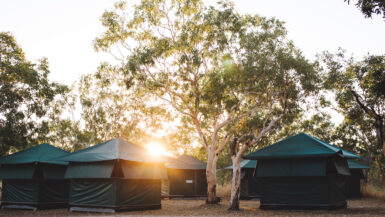Norway is a country known for its stunning natural beauty and commitment to sustainability. For those who love the great outdoors, camping is the perfect way to immerse oneself in Norway’s pristine landscapes. However, it’s important to choose a camping site that is environmentally responsible and sustainable. In this article, we will introduce you to the best eco-friendly camping sites in Norway, where you can enjoy the beauty of nature without harming the environment. From solar-powered cabins to composting toilets, these campsites are leading the way in sustainable tourism and offer a unique and unforgettable camping experience.
Introduction to Eco-Friendly Camping in Norway
Camping in Norway is an unforgettable experience, with stunning landscapes, fresh air, and a chance to reconnect with nature. However, it is important to consider the impact that camping can have on the environment. This is where eco-friendly camping comes in. Eco-friendly camping, also known as sustainable camping, involves minimizing your impact on the environment while enjoying the great outdoors.
Norway is a country that is deeply committed to preserving its natural beauty and promoting sustainable tourism. Many camping sites in Norway have embraced eco-friendly practices, such as using renewable energy sources, implementing waste reduction strategies, and promoting responsible use of natural resources.
In this article, we will explore the best eco-friendly camping sites in Norway, as well as tips and tricks for reducing your carbon footprint while camping. Whether you are a seasoned camper or a first-timer, we hope to inspire you to experience the beauty of Norway in a sustainable way.
The Importance of Sustainable Tourism in Norway
Norway is a country that takes sustainability seriously. In fact, the Norwegian government has set a goal to become a carbon-neutral country by 2030. This commitment to sustainability extends to the tourism industry, where many businesses are taking steps to reduce their impact on the environment.
Sustainable tourism is important in Norway for several reasons. Firstly, Norway is home to some of the world’s most beautiful natural landscapes, including fjords, mountains, and forests. These landscapes are a major draw for tourists, but they are also fragile and need to be protected. By promoting sustainable tourism practices, Norway can ensure that its natural beauty is preserved for future generations to enjoy.
Secondly, sustainable tourism can have a positive impact on the local economy. By supporting eco-friendly businesses, tourists can help to create jobs and support local communities. Additionally, sustainable tourism can help to promote cultural exchange and understanding between tourists and locals.
Finally, sustainable tourism is important for the global environment. Tourism is a major source of greenhouse gas emissions, and by promoting sustainable tourism practices, Norway can help to mitigate the impact of tourism on the planet.
Overall, sustainable tourism is essential for the long-term health of Norway’s environment, economy, and society. By choosing eco-friendly camping sites and engaging in sustainable tourism practices, tourists can help to ensure that Norway remains a beautiful and vibrant destination for years to come.
Top Eco-Friendly Camping Sites in Norway
Norway is home to some of the most beautiful and eco-friendly camping sites in the world. Here are some of the top eco-friendly camping sites in Norway that are perfect for anyone looking to experience the beauty of Norway in a sustainable way:
1. Jotunheimen National Park
Jotunheimen National Park is a stunning wilderness area located in central Norway. The park is home to many eco-friendly camping sites, including Gjendesheim and Memurubu. These camping sites are committed to sustainable tourism practices, such as using renewable energy sources and minimizing waste. The park also offers a range of activities, including hiking, fishing, and kayaking.
2. Hardangervidda National Park
Hardangervidda National Park is the largest national park in Norway and is home to some of the country’s most spectacular scenery. The park has several eco-friendly camping sites, including the Rauhelleren Tourist Cabin, which is powered by solar panels and has a composting toilet. Visitors can enjoy hiking, fishing, and skiing in the park.
3. Lofoten Islands
The Lofoten Islands are a group of islands located in northern Norway. The islands are known for their stunning natural beauty and eco-friendly tourism practices. The camping sites on the islands, such as the Ballstad Camping and Lofoten Camping, are committed to sustainable tourism practices, such as using renewable energy and minimizing waste. Visitors can enjoy hiking, fishing, and kayaking in the area.
4. Femundsmarka National Park
Femundsmarka National Park is a pristine wilderness area located in southeastern Norway. The park has several eco-friendly camping sites, including the Femundtunet Camping, which is powered by solar panels and has a composting toilet. Visitors can enjoy hiking, fishing, and canoeing in the park.
These are just a few of the many eco-friendly camping sites in Norway that are perfect for anyone looking to experience the beauty of Norway in a sustainable way. Regardless of which camping site you choose, you can be sure that you will be surrounded by stunning natural scenery and committed to sustainable tourism practices.
Detailed Description of Each Camping Site
Here is a more detailed description of each of the eco-friendly camping sites mentioned above:
Jotunheimen National Park
Gjendesheim is a popular eco-friendly camping site located in Jotunheimen National Park. The camping site is committed to sustainable tourism practices, such as using renewable energy sources and minimizing waste. The site offers a range of accommodation options, including cabins and tents. Visitors can also take part in a range of activities, such as hiking, fishing, and kayaking.
Memurubu is another eco-friendly camping site located in Jotunheimen National Park. The site is powered by renewable energy sources, such as solar panels and hydroelectricity. The site offers a range of accommodation options, including cabins and tents. Visitors can also take part in a range of activities, such as hiking, fishing, and kayaking.
Hardangervidda National Park
Rauhelleren Tourist Cabin is an eco-friendly camping site located in Hardangervidda National Park. The site is powered by solar panels and has a composting toilet. Visitors can stay in the cabin or pitch a tent. The site offers a range of activities, such as hiking, fishing, and skiing.
Lofoten Islands
Ballstad Camping is an eco-friendly camping site located on the Lofoten Islands. The site is committed to sustainable tourism practices, such as using renewable energy sources and minimizing waste. The site offers a range of accommodation options, including cabins and tents. Visitors can also take part in a range of activities, such as hiking, fishing, and kayaking.
Lofoten Camping is another eco-friendly camping site located on the Lofoten Islands. The site is powered by renewable energy sources, such as solar panels and wind turbines. The site offers a range of accommodation options, including cabins and tents. Visitors can also take part in a range of activities, such as hiking, fishing, and kayaking.
Femundsmarka National Park
Femundtunet Camping is an eco-friendly camping site located in Femundsmarka National Park. The site is powered by solar panels and has a composting toilet. Visitors can stay in cabins or pitch a tent. The site offers a range of activities, such as hiking, fishing, and canoeing.
Each of these eco-friendly camping sites in Norway offers a unique experience, but they all share a commitment to sustainable tourism practices and a love for the natural beauty of Norway.
Activities and Attractions Near the Camping Sites
Norway is home to some of the most stunning natural landscapes in the world, and the eco-friendly camping sites mentioned above are all located in areas with plenty of activities and attractions nearby. Here are some of the top activities and attractions near each camping site:
Jotunheimen National Park
In addition to the activities offered at the eco-friendly camping sites in Jotunheimen National Park, visitors can also take part in a range of activities in the surrounding area. The park is home to some of Norway’s highest mountains, including Galdhøpiggen, which is the highest peak in Norway. Visitors can also explore the many glaciers, lakes, and rivers in the park.
Hardangervidda National Park
Hardangervidda National Park is a popular destination for hiking and skiing. The park has over 1,000 kilometers of marked hiking trails, ranging from easy walks to challenging multi-day hikes. In the winter, visitors can enjoy cross-country skiing and snowshoeing.
Lofoten Islands
The Lofoten Islands are known for their stunning natural beauty, with towering mountains, crystal-clear waters, and pristine beaches. Visitors can take part in a range of outdoor activities, such as hiking, fishing, and kayaking. The islands are also home to several charming fishing villages, where visitors can learn about the local culture and history.
Femundsmarka National Park
Femundsmarka National Park is a wilderness area that is perfect for outdoor enthusiasts. Visitors can take part in a range of activities, such as hiking, fishing, and canoeing. The park is also home to a variety of wildlife, including moose, reindeer, and beavers.
Overall, each of these eco-friendly camping sites in Norway offers a range of activities and attractions that are sure to appeal to anyone looking to experience the beauty of Norway in a sustainable way.
Tips for Eco-Friendly Camping in Norway
Camping in Norway can be a great way to experience the beauty of the country while minimizing your impact on the environment. Here are some tips for eco-friendly camping in Norway:
1. Choose an eco-friendly camping site
As we have mentioned earlier, Norway has many eco-friendly camping sites that are committed to sustainable tourism practices. By choosing an eco-friendly camping site, you can be sure that you are minimizing your impact on the environment.
2. Minimize waste
When camping, it is important to minimize waste as much as possible. Bring reusable containers and utensils, and avoid single-use items such as plastic bags and paper plates. Make sure to properly dispose of any waste you do generate, and consider packing out any non-biodegradable waste.
3. Use renewable energy sources
If possible, use renewable energy sources such as solar panels or wind turbines to power your camping equipment. This will help to reduce your carbon footprint and minimize your impact on the environment.
4. Respect nature
When camping in Norway, it is important to respect nature and leave no trace. Avoid damaging plants or trees, and do not disturb wildlife. Stick to designated trails and campsites, and avoid creating new trails or campsites.
5. Support local businesses
When camping in Norway, consider supporting local businesses that are committed to sustainable tourism practices. This can help to promote sustainable tourism and support local communities.
By following these tips, you can enjoy eco-friendly camping in Norway while minimizing your impact on the environment.
How to Reduce Your Carbon Footprint While Camping
Camping is a great way to connect with nature and enjoy the great outdoors. However, it’s important to be mindful of your impact on the environment while camping. Here are some tips for reducing your carbon footprint while camping in Norway:
Choose Eco-Friendly Camping Gear and Equipment
When shopping for camping gear, look for products that are eco-friendly and sustainable. Choose gear made from natural materials such as cotton, wool, and bamboo, and avoid synthetic materials that are harmful to the environment. Opt for gear that is durable and long-lasting, so you don’t have to replace it as often.
Minimize Your Waste
When camping, it’s important to minimize your waste and dispose of it properly. Bring reusable containers for food and drinks, and avoid single-use plastic products. Pack out all your trash and leave your campsite cleaner than you found it.
Reduce Your Energy Consumption
When camping, it’s easy to rely on energy-consuming devices like lanterns and stoves. However, these can have a significant impact on the environment. Instead, opt for solar-powered devices or use low-energy alternatives like candles and a campfire for lighting and cooking.
Use Public Transportation
Driving to your camping destination can have a significant impact on the environment. Consider using public transportation, biking, or walking to your campsite instead. Not only is it better for the environment, but it can also be a great way to see more of Norway’s beautiful scenery.
Respect Wildlife and Nature
When camping in Norway, it’s important to respect the wildlife and nature around you. Avoid disturbing wildlife, and keep a safe distance from animals you encounter. Stick to designated trails to avoid damaging vegetation, and avoid using soap or other products in natural water sources.
By following these tips, you can reduce your carbon footprint while camping in Norway and help preserve the natural environment for future generations to enjoy.
Sustainable Camping Gear and Equipment
When planning a camping trip, it’s important to choose gear and equipment that is eco-friendly and sustainable. Here are some tips for selecting sustainable camping gear:
Choose Durable and Long-Lasting Gear
Investing in high-quality camping gear that is durable and long-lasting is an excellent way to reduce your environmental impact. Look for gear made from natural materials such as cotton, wool, and bamboo, which are biodegradable and sustainable.
Opt for Solar-Powered Devices
Using solar-powered devices is a great way to reduce your carbon footprint while camping. Solar-powered lanterns, stoves, and chargers are widely available and can be charged using the sun’s energy, making them a sustainable and eco-friendly option.
Bring Reusable Containers and Utensils
Using reusable containers and utensils is an easy way to reduce waste while camping. Bring reusable plates, cups, and utensils, and consider using a reusable water bottle instead of single-use plastic bottles.
Use Biodegradable Soap and Cleaning Products
When washing dishes or cleaning up around your campsite, it’s important to use biodegradable soap and cleaning products. These products are designed to break down naturally in the environment and won’t harm wildlife or vegetation.
Avoid Single-Use Products
Avoiding single-use products like plastic bags, straws, and utensils is an important step in reducing your environmental impact while camping. Instead, opt for reusable products that can be washed and used again.
By following these tips, you can select sustainable camping gear and equipment that will help reduce your environmental impact while enjoying Norway’s beautiful scenery.
Local Food and Drink Options for Eco-Friendly Camping
One of the best things about camping in Norway is the opportunity to enjoy the delicious local cuisine. Here are some tips for selecting eco-friendly and sustainable food and drink options while camping:
Choose Locally Sourced Foods
When shopping for food for your camping trip, look for locally sourced options. Not only are these foods fresher and more delicious, but they also have a lower carbon footprint since they don’t have to be transported long distances.
Bring Reusable Containers and Utensils
Using reusable containers and utensils is not only great for reducing waste, but it can also be a more sustainable option. Consider bringing a reusable coffee mug, water bottle, and food containers with you on your camping trip.
Opt for Sustainable and Organic Products
Choosing sustainable and organic food and drink products is a great way to support eco-friendly farming practices. Look for products that are certified organic, fair trade, or sustainably sourced.
Avoid Single-Use Products
Avoiding single-use products like plastic bags, straws, and utensils is an important step in reducing your environmental impact while camping. Instead, opt for reusable products that can be washed and used again.
Consider Catching Your Own Food
If you’re an experienced angler, consider catching your own fish to cook over the campfire. Not only is it a fun and rewarding experience, but it’s also a sustainable way to enjoy fresh, local seafood.
By following these tips, you can enjoy delicious local food and drink options while camping in Norway, while also reducing your environmental impact and supporting sustainable farming practices.





Leave a reply